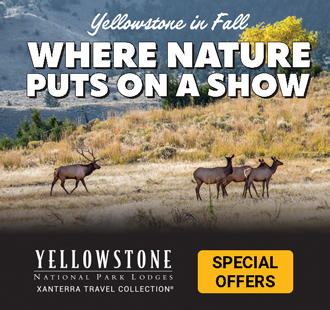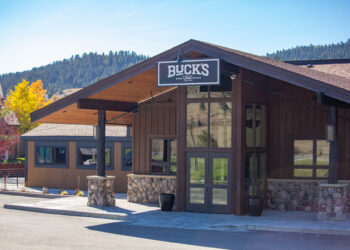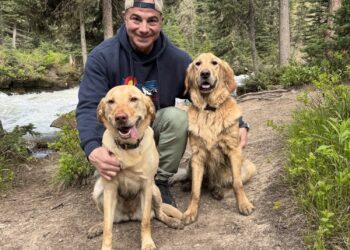By Jessianne Castle ENVIRONMENTAL AND OUTDOORS EDITOR
YELLOWSTONE NATIONAL PARK – Beneath a mezzanine crafted with local logs, on a floor crowded with visitors, in a room homey with the subtle hint of wood smoke from more than 100 years of fires in the massive stone fireplace, nine indigenous artists celebrated a returning to their homeland.
The first annual Tribal Marketplace at Yellowstone, held at the historic Old Faithful Inn from June 11-14, honored Plains Indian art and culture with a fashion show, demonstrations and a vendor market.
“We’re privileged to be stewards of the world’s first national park and the relationship of Native people with this area goes back a very long time,” said Karen Tryman, director of retail for event host Yellowstone National Park Lodges. “[The marketplace] is a celebration of that relationship and the heritage that we all share.”
The artists were overwhelmingly excited to be a part of this new event, proud to represent their culture in an area that was once frequented by their ancestors. Prior to the Indian Removal Act of 1830 and ensuing decades of relocation policy, Plains tribes such as the Blackfeet, Shoshone and Crow occupied the land that is now Yellowstone National Park.
Joanne Brings Thunder, a member of the Eastern Band of Shoshone from the Wind River Reservation in Wyoming, said she is grateful to represent her tribe in Yellowstone as a Shoshone, a resident of Wyoming and as an artist, adding that her great- great- great-grandfather, Chief Washakie, was involved with land cessation negotiations throughout the area in the 1860s.
The artist creates beadwork, painting and textiles, weaving together traditional designs with contemporary shapes and colors. One example is her use of glitter on hand-painted earrings. “I know that if my ancestors had access to glitter, it would be on everything,” she laughed.
Brings Thunder said Native art is vastly underrepresented, so at shows like this she feels like an ambassador. “Our culture is still alive and living. That’s a huge inspiration for me,” she said. “Our art forms are so unique. They’re strong enough to stand on their own.”
In addition to the daily market, the Tribal Marketplace included an evening fashion show on June 11. Park staff and Native models paraded around the inn’s second-floor mezzanine, dressed in bright colors and unique designs.

Della Bighair-Stump, an enrolled member of the Apsaalooke (Crow) Tribe of Montana, showcased her dresses, scarves, jackets and leggings, created under the label Designs by Della. While Bighair-Stump beads—creating her family’s own regalia for powwows and other events—many of her pieces for sale incorporate beaded-print fabrics that have been scanned from her own beading. Printed on velvet, this design appears like actual beads and is a clear example of the blend of traditional and contemporary.
“I love the color and I love the effect,” she said.
Additional artists presented traditionally beaded jewelry, upcycled purses, canvas paintings and dolls. Cedar Rose Bulltail of the Crow Agency shared information about her different skin-care products, which are made in small batches from native plants on her reservation, including yarrow, juniper and mint.
Many Yellowstone National Park visitors meandered through the vendor display, showing interest and appreciation in both the art and culture of the Plains Indians.
Kim Romain, of Evanston, Illinois, was visiting the park as a part of a cross-country family road trip, and Yellowstone was among several national parks on the itinerary. She said she valued the Tribal Marketplace for giving indigenous people a place in Yellowstone.
“We’re on their land. We continue to be on their land,” Romain said. “I believe the more Native presence, the better we all can understand ourselves and our nation.”














